Avideh Zakhor
Versatile Locomotion Skills for Hexapod Robots
Dec 14, 2024



Abstract:Hexapod robots are potentially suitable for carrying out tasks in cluttered environments since they are stable, compact, and light weight. They also have multi-joint legs and variable height bodies that make them good candidates for tasks such as stairs climbing and squeezing under objects in a typical home environment or an attic. Expanding on our previous work on joist climbing in attics, we train a legged hexapod equipped with a depth camera and visual inertial odometry (VIO) to perform three tasks: climbing stairs, avoiding obstacles, and squeezing under obstacles such as a table. Our policies are trained with simulation data only and can be deployed on lowcost hardware not requiring real-time joint state feedback. We train our model in a teacher-student model with 2 phases: In phase 1, we use reinforcement learning with access to privileged information such as height maps and joint feedback. In phase 2, we use supervised learning to distill the model into one with access to only onboard observations, consisting of egocentric depth images and robot pose captured by a tracking VIO camera. By manipulating available privileged information, constructing simulation terrains, and refining reward functions during phase 1 training, we are able to train the robots with skills that are robust in non-ideal physical environments. We demonstrate successful sim-to-real transfer and achieve high success rates across all three tasks in physical experiments.
Swap Path Network for Robust Person Search Pre-training
Dec 06, 2024Abstract:In person search, we detect and rank matches to a query person image within a set of gallery scenes. Most person search models make use of a feature extraction backbone, followed by separate heads for detection and re-identification. While pre-training methods for vision backbones are well-established, pre-training additional modules for the person search task has not been previously examined. In this work, we present the first framework for end-to-end person search pre-training. Our framework splits person search into object-centric and query-centric methodologies, and we show that the query-centric framing is robust to label noise, and trainable using only weakly-labeled person bounding boxes. Further, we provide a novel model dubbed Swap Path Net (SPNet) which implements both query-centric and object-centric training objectives, and can swap between the two while using the same weights. Using SPNet, we show that query-centric pre-training, followed by object-centric fine-tuning, achieves state-of-the-art results on the standard PRW and CUHK-SYSU person search benchmarks, with 96.4% mAP on CUHK-SYSU and 61.2% mAP on PRW. In addition, we show that our method is more effective, efficient, and robust for person search pre-training than recent backbone-only pre-training alternatives.
Scalable Indoor Novel-View Synthesis using Drone-Captured 360 Imagery with 3D Gaussian Splatting
Oct 15, 2024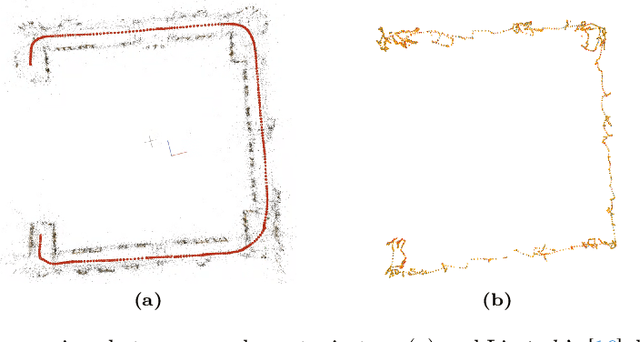

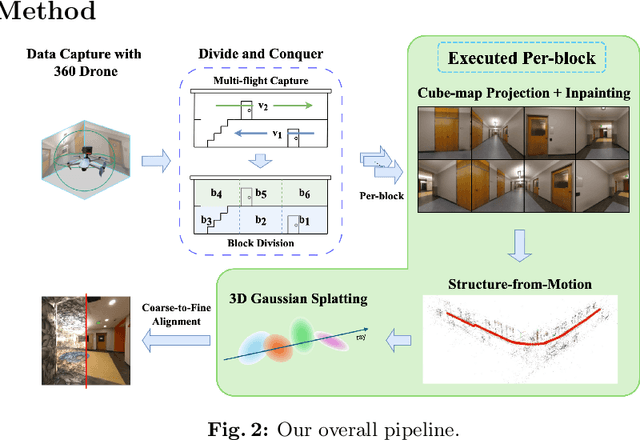
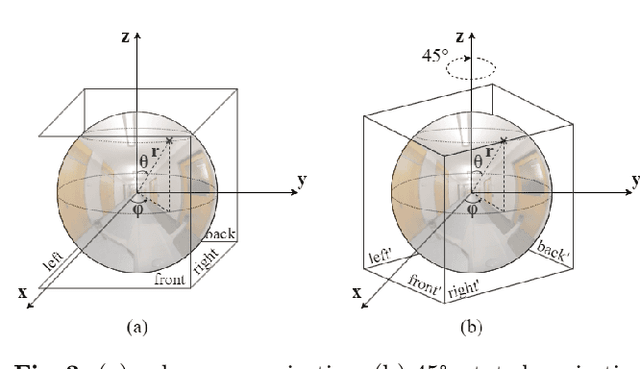
Abstract:Scene reconstruction and novel-view synthesis for large, complex, multi-story, indoor scenes is a challenging and time-consuming task. Prior methods have utilized drones for data capture and radiance fields for scene reconstruction, both of which present certain challenges. First, in order to capture diverse viewpoints with the drone's front-facing camera, some approaches fly the drone in an unstable zig-zag fashion, which hinders drone-piloting and generates motion blur in the captured data. Secondly, most radiance field methods do not easily scale to arbitrarily large number of images. This paper proposes an efficient and scalable pipeline for indoor novel-view synthesis from drone-captured 360 videos using 3D Gaussian Splatting. 360 cameras capture a wide set of viewpoints, allowing for comprehensive scene capture under a simple straightforward drone trajectory. To scale our method to large scenes, we devise a divide-and-conquer strategy to automatically split the scene into smaller blocks that can be reconstructed individually and in parallel. We also propose a coarse-to-fine alignment strategy to seamlessly match these blocks together to compose the entire scene. Our experiments demonstrate marked improvement in both reconstruction quality, i.e. PSNR and SSIM, and computation time compared to prior approaches.
Adapting Segment Anything Model to Melanoma Segmentation in Microscopy Slide Images
Oct 03, 2024



Abstract:Melanoma segmentation in Whole Slide Images (WSIs) is useful for prognosis and the measurement of crucial prognostic factors such as Breslow depth and primary invasive tumor size. In this paper, we present a novel approach that uses the Segment Anything Model (SAM) for automatic melanoma segmentation in microscopy slide images. Our method employs an initial semantic segmentation model to generate preliminary segmentation masks that are then used to prompt SAM. We design a dynamic prompting strategy that uses a combination of centroid and grid prompts to achieve optimal coverage of the super high-resolution slide images while maintaining the quality of generated prompts. To optimize for invasive melanoma segmentation, we further refine the prompt generation process by implementing in-situ melanoma detection and low-confidence region filtering. We select Segformer as the initial segmentation model and EfficientSAM as the segment anything model for parameter-efficient fine-tuning. Our experimental results demonstrate that this approach not only surpasses other state-of-the-art melanoma segmentation methods but also significantly outperforms the baseline Segformer by 9.1% in terms of IoU.
Gallery Filter Network for Person Search
Oct 25, 2022Abstract:In person search, we aim to localize a query person from one scene in other gallery scenes. The cost of this search operation is dependent on the number of gallery scenes, making it beneficial to reduce the pool of likely scenes. We describe and demonstrate the Gallery Filter Network (GFN), a novel module which can efficiently discard gallery scenes from the search process, and benefit scoring for persons detected in remaining scenes. We show that the GFN is robust under a range of different conditions by testing on different retrieval sets, including cross-camera, occluded, and low-resolution scenarios. In addition, we develop the base SeqNeXt person search model, which improves and simplifies the original SeqNet model. We show that the SeqNeXt+GFN combination yields significant performance gains over other state-of-the-art methods on the standard PRW and CUHK-SYSU person search datasets. To aid experimentation for this and other models, we provide standardized tooling for the data processing and evaluation pipeline typically used for person search research.
Misinformation Detection in Social Media Video Posts
Feb 15, 2022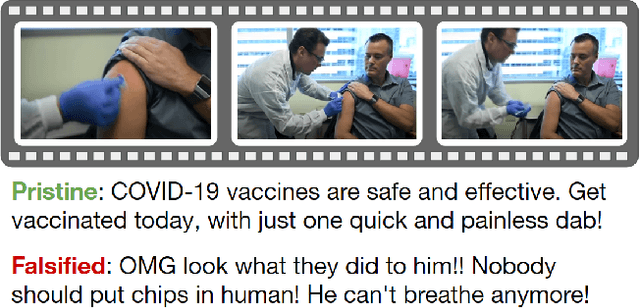

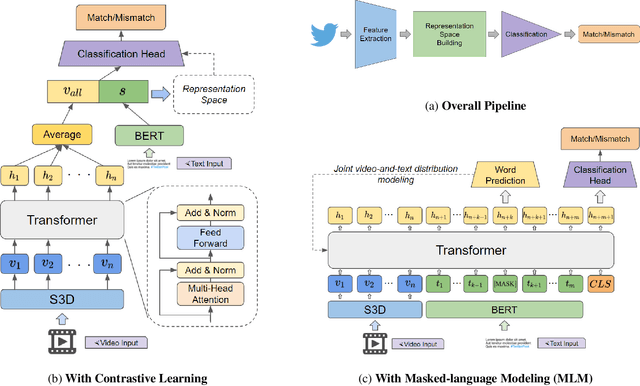
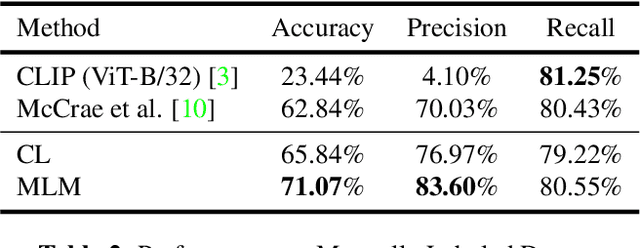
Abstract:With the growing adoption of short-form video by social media platforms, reducing the spread of misinformation through video posts has become a critical challenge for social media providers. In this paper, we develop methods to detect misinformation in social media posts, exploiting modalities such as video and text. Due to the lack of large-scale public data for misinformation detection in multi-modal datasets, we collect 160,000 video posts from Twitter, and leverage self-supervised learning to learn expressive representations of joint visual and textual data. In this work, we propose two new methods for detecting semantic inconsistencies within short-form social media video posts, based on contrastive learning and masked language modeling. We demonstrate that our new approaches outperform current state-of-the-art methods on both artificial data generated by random-swapping of positive samples and in the wild on a new manually-labeled test set for semantic misinformation.
Recognition-Aware Learned Image Compression
Feb 01, 2022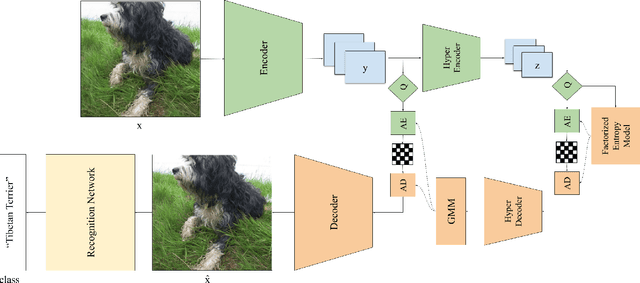
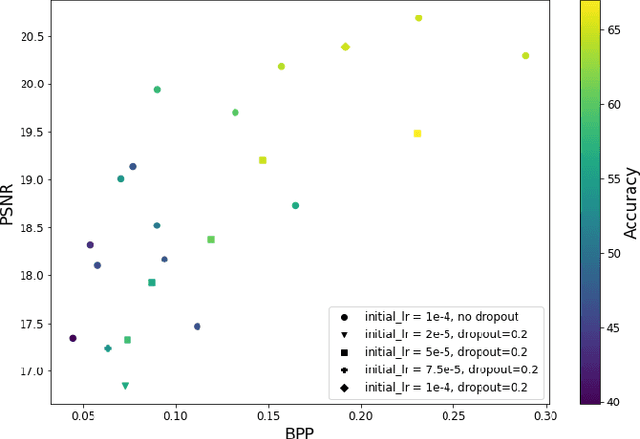


Abstract:Learned image compression methods generally optimize a rate-distortion loss, trading off improvements in visual distortion for added bitrate. Increasingly, however, compressed imagery is used as an input to deep learning networks for various tasks such as classification, object detection, and superresolution. We propose a recognition-aware learned compression method, which optimizes a rate-distortion loss alongside a task-specific loss, jointly learning compression and recognition networks. We augment a hierarchical autoencoder-based compression network with an EfficientNet recognition model and use two hyperparameters to trade off between distortion, bitrate, and recognition performance. We characterize the classification accuracy of our proposed method as a function of bitrate and find that for low bitrates our method achieves as much as 26% higher recognition accuracy at equivalent bitrates compared to traditional methods such as Better Portable Graphics (BPG).
Drone Object Detection Using RGB/IR Fusion
Jan 11, 2022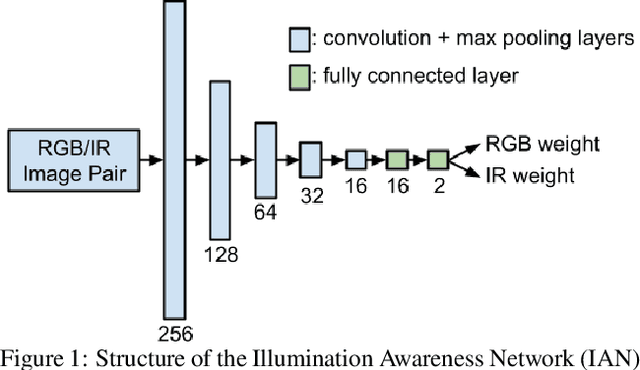
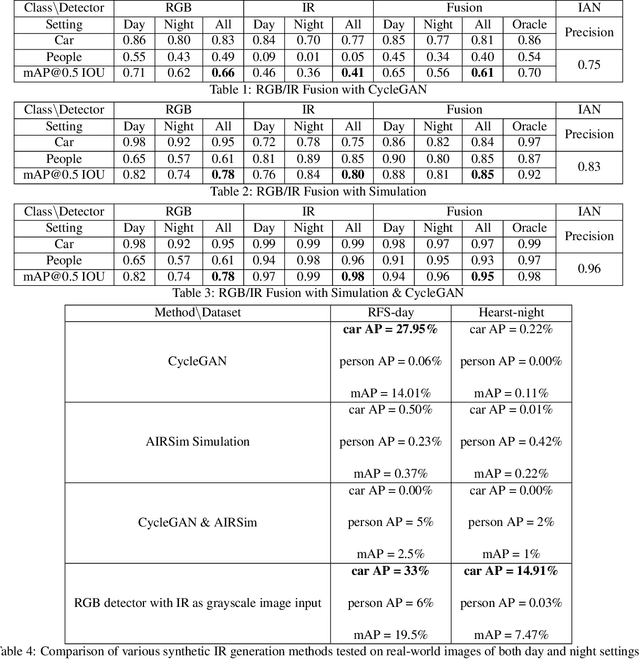


Abstract:Object detection using aerial drone imagery has received a great deal of attention in recent years. While visible light images are adequate for detecting objects in most scenarios, thermal cameras can extend the capabilities of object detection to night-time or occluded objects. As such, RGB and Infrared (IR) fusion methods for object detection are useful and important. One of the biggest challenges in applying deep learning methods to RGB/IR object detection is the lack of available training data for drone IR imagery, especially at night. In this paper, we develop several strategies for creating synthetic IR images using the AIRSim simulation engine and CycleGAN. Furthermore, we utilize an illumination-aware fusion framework to fuse RGB and IR images for object detection on the ground. We characterize and test our methods for both simulated and actual data. Our solution is implemented on an NVIDIA Jetson Xavier running on an actual drone, requiring about 28 milliseconds of processing per RGB/IR image pair.
Immediate Proximity Detection Using Wi-Fi-Enabled Smartphones
Jun 05, 2021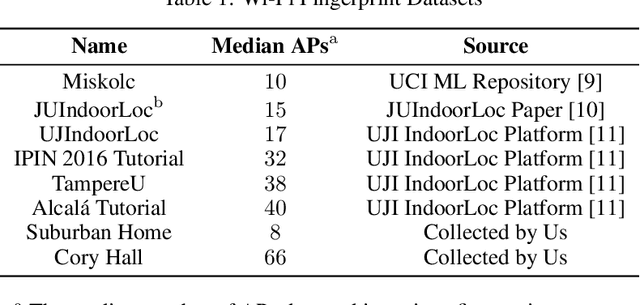
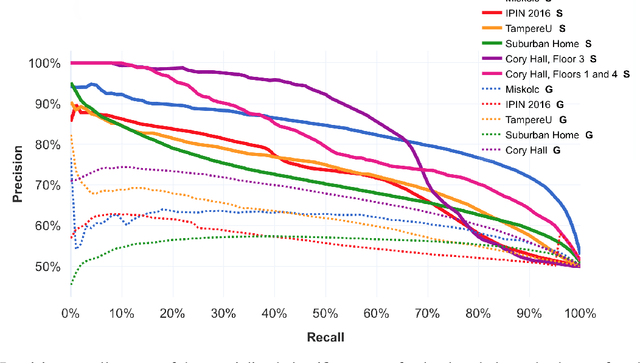
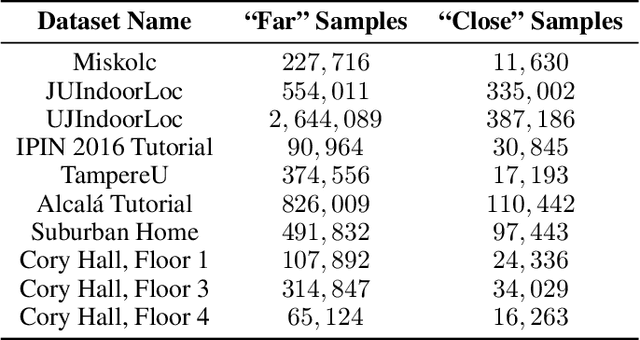
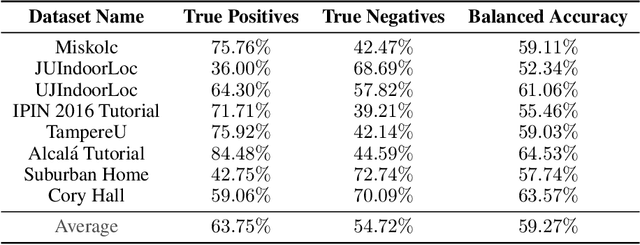
Abstract:Smartphone apps for exposure notification and contact tracing have been shown to be effective in controlling the COVID-19 pandemic. However, Bluetooth Low Energy tokens similar to those broadcast by existing apps can still be picked up far away from the transmitting device. In this paper, we present a new class of methods for detecting whether or not two Wi-Fi-enabled devices are in immediate physical proximity, i.e. 2 or fewer meters apart, as established by the U.S. Centers for Disease Control and Prevention (CDC). Our goal is to enhance the accuracy of smartphone-based exposure notification and contact tracing systems. We present a set of binary machine learning classifiers that take as input pairs of Wi-Fi RSSI fingerprints. We empirically verify that a single classifier cannot generalize well to a range of different environments with vastly different numbers of detectable Wi-Fi Access Points (APs). However, specialized classifiers, tailored to situations where the number of detectable APs falls within a certain range, are able to detect immediate physical proximity significantly more accurately. As such, we design three classifiers for situations with low, medium, and high numbers of detectable APs. These classifiers distinguish between pairs of RSSI fingerprints recorded 2 or fewer meters apart and pairs recorded further apart but still in Bluetooth range. We characterize their balanced accuracy for this task to be between 66.8% and 77.8%.
Multi-Modal Semantic Inconsistency Detection in Social Media News Posts
May 26, 2021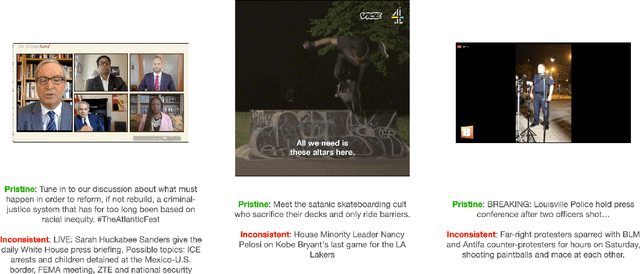
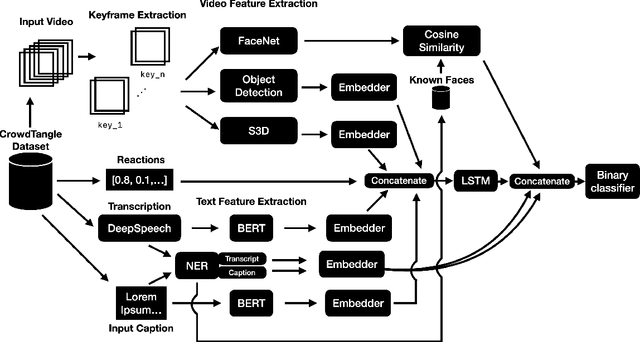
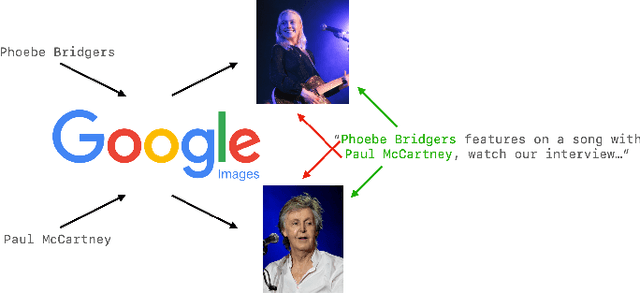

Abstract:As computer-generated content and deepfakes make steady improvements, semantic approaches to multimedia forensics will become more important. In this paper, we introduce a novel classification architecture for identifying semantic inconsistencies between video appearance and text caption in social media news posts. We develop a multi-modal fusion framework to identify mismatches between videos and captions in social media posts by leveraging an ensemble method based on textual analysis of the caption, automatic audio transcription, semantic video analysis, object detection, named entity consistency, and facial verification. To train and test our approach, we curate a new video-based dataset of 4,000 real-world Facebook news posts for analysis. Our multi-modal approach achieves 60.5% classification accuracy on random mismatches between caption and appearance, compared to accuracy below 50% for uni-modal models. Further ablation studies confirm the necessity of fusion across modalities for correctly identifying semantic inconsistencies.
 Add to Chrome
Add to Chrome Add to Firefox
Add to Firefox Add to Edge
Add to Edge